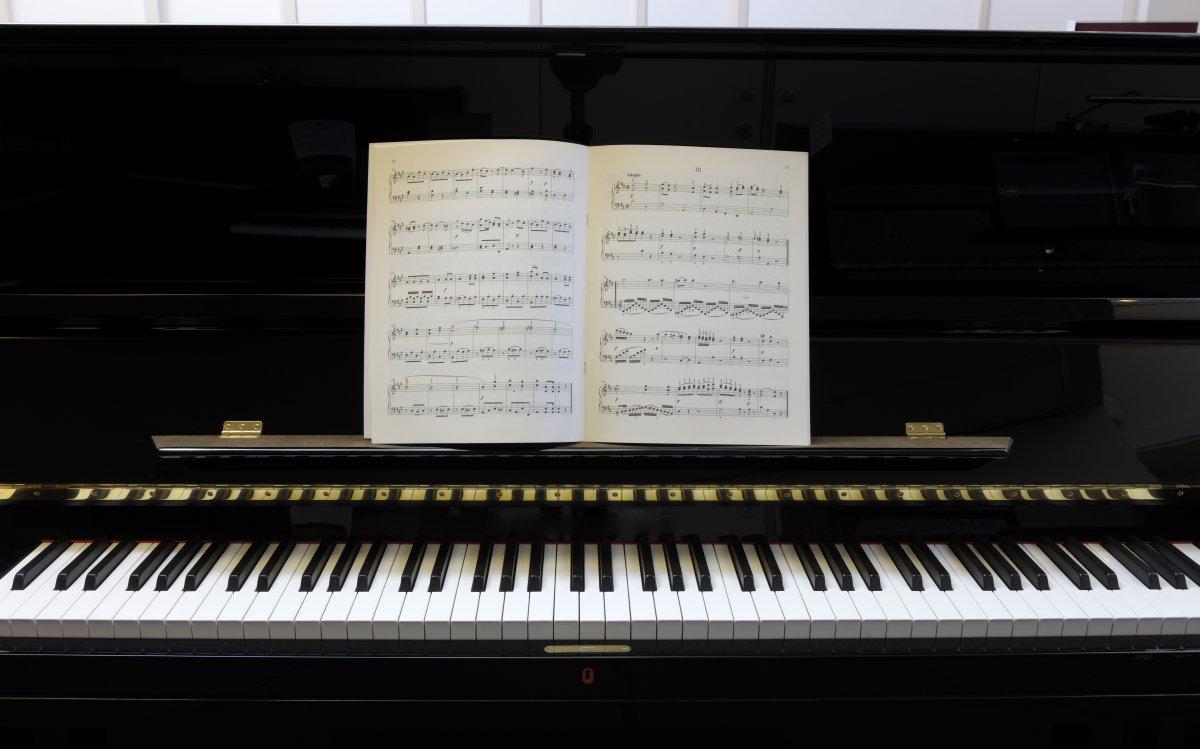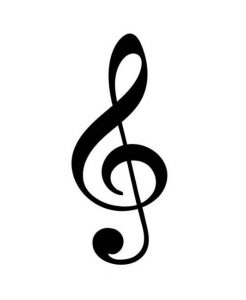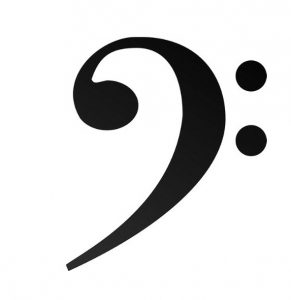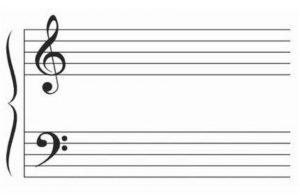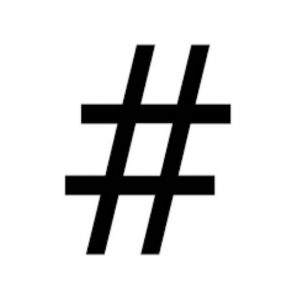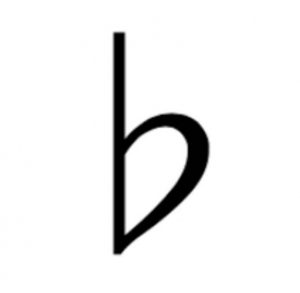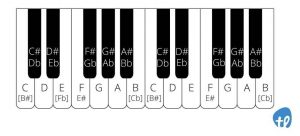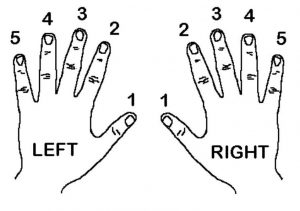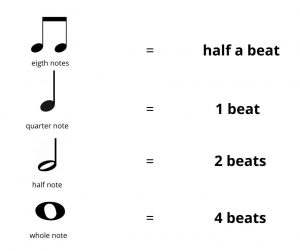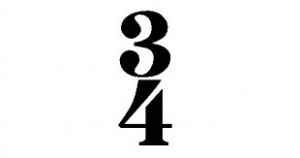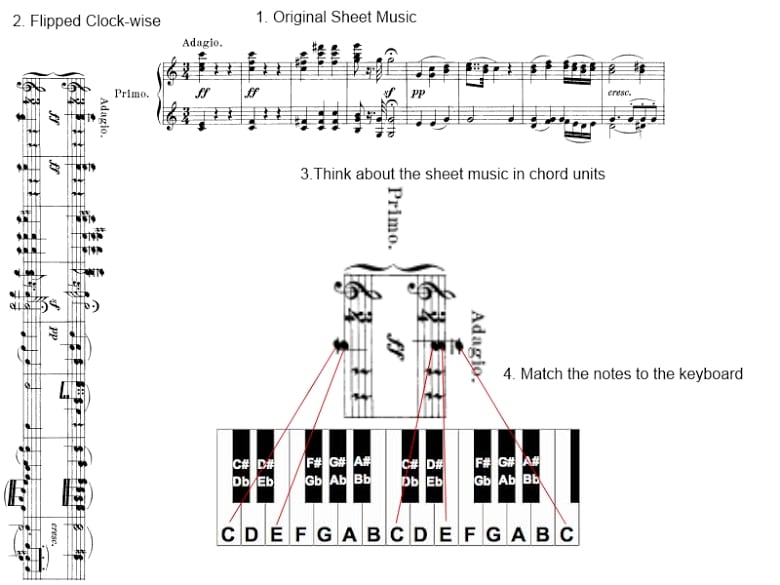Learning how to read music notes may seem complex, but it’s simpler than you think. You simply need to learn the names of the lines and spaces on the musical staff, understand note values, and then discover how the symbols on the page relate to your right and left hands on the keyboard. Then, all you need is to practice starting with beginner piano sheet music. We’ll cover all of these topics in this article.
After all, we’ve all heard a tune on the radio and thought, “Wow, I would love to be able to play that.” And we’ve all been envious of friends and family members who have performed in bands, constantly fantasizing about rocking out on stage with them. But how do you make those musical dreams become a reality?
Whether you want to casually play the piano at a party or tickle the ivories like a professional in a dimly-lit cocktail lounge, developing your music reading skills is the first step. Knowing how will give you an advantage in musical situations.
How Hard is it to Read Sheet Music?
It can be challenging to learn how to read sheet music, but it’s vital. Here are some of the basics:
- Reading sheet music is an essential skill for many musical instruments.
- It takes time, practice, and dedication to learn how to read sheet music.
- Different symbols are used on sheet music to indicate notes, chords, rhythm, dynamics, and more.
- A person can become a proficient reader of sheet music by doing research, taking lessons, and practicing regularly.
Ready to learn everything you need to know about reading sheet music? Whether you’re a piano player or you want to master some other instrument, taking music theory lessons can help. Check out the benefits of doing so by watching the video below:
https://www.youtube.com/watch?v=zrwEgHDT8jg
Why Learn How to Read Music?
Reading music means you can see and understand the structure of the piece and how it’s put together, allowing you to develop a greater understanding of the whole composition. The symbols of sheet music, like most spoken languages, have been around for centuries. Each symbol represents a different pitch, rhythm, and tempo of a specific song. The symbols also represent the techniques used by whoever is playing that musical piece.
Some musicians will tell you that reading piano sheet music isn’t necessary to be a competent player, but you only limit yourself by going that route. Many pianists will attest that learning and studying sheet music early and often is the right choice.
Learning this essential skill:
- Unlocks a world of expression and freedom on the piano
- Means you’ll be able to play in a band or other ensemble
- Helps you sight read on other instruments including strings, brass, or woodwinds
- Allows you to communicate about music with other musicians
Even if your main instrument is not the piano, learning the basics of how to read music note names can be easier when you know your way around a keyboard.
Studying the piano and learning how to read sheet music go hand-in-hand. To develop your skills in the most efficient way possible, you must start learning how to read sheet music right off the bat.
How Do You Read Sheet Music Properly?
In this post, we’ll focus primarily on how to read piano sheet music. However, if you aren’t a pianist, you might be wondering how to read sheet music for other instruments. Here’s a complete guide that will cover sheet music – how to read for any instrument.
How to Read Sheet Music for Guitar
The first step when it comes to reading sheet music for guitar is to become familiar with the different parts of a piece of sheet music. This includes the clef, key signature, time signature, and notes themselves. Once you understand these basic components, you can begin to practice playing simple tunes while following along with the sheet music.
One of the most critical elements of reading guitar sheet music is understanding rhythm and tempo.
Pay particular attention to the time signature, which tells you how many beats are in each bar, and the tempo marking, which indicates the speed at which the piece should be played. Practice playing slowly at first to get the rhythm down, then gradually increase the tempo as you become more comfortable with the piece.
You can find more tips on how to read guitar sheet music here.
How to Read Drum Sheet Music
Drum sheet music can look quite different from other instrument sheet music, as it is often written on a staff with up to five lines and is sometimes called a percussion clef. It’s also important to remember that drummers read sheet music differently than other musicians, as they are often looking at multiple pieces of sheet music at the same time.
When it comes to drum sheet music, there are several crucial elements that you need to be familiar with. These include the note values, which dictate how long a particular sound should be held, and the legend or key, which tells you which drum or cymbal to play. Additionally, understanding the different dynamic markings, such as forte or piano, can help you play the piece more accurately.
Find out more about how to read sheet music for drums here.
How to Read Violin Sheet Music
When it comes to reading sheet music for the violin, one of the most critical things to understand is the finger placement. Unlike many other instruments, the violin requires a high level of precision and accuracy when it comes to finger placement to play the correct notes. Becoming familiar with the fingerboard and understanding the different string positions can greatly improve your ability to read and play music on the violin.
Another important thing to remember when reading sheet music for the violin is the bowing technique. The bowing can dictate the tone and dynamic of the piece, so it’s important to pay attention to the markings and directions provided. By practicing both your finger placement and bowing techniques, you can become a proficient player of the violin in no time.
Read more about how to read notes on sheet music for violin here.
How to Read Ukulele Sheet Music
The ukulele is a unique instrument that is often associated with Hawaiian music and culture. When it comes to reading sheet music for the ukulele, the primary difference from other instruments is the tuning.
Ukuleles are usually tuned to the G-C-E-A notes, which can vary from other instruments. Therefore, understanding the notes and chord progressions for the ukulele is essential.
It’s important to pay attention to strumming patterns and rhythms when reading ukulele sheet music. The ukulele is often strummed, which can change the feel and tempo of a piece. By becoming familiar with different strumming patterns and practicing them along with the sheet music, you can quickly become proficient at playing any ukulele song.
You can learn more here.
How to Read Piano Sheet Music
Learning how to read music as a beginner simply means learning what the symbols on the page are telling your hands to do. This includes knowing the names of the piano keys, the notes on the musical staff, time signatures, note values, and different musical symbols.
But, before we dive into basic music reading skills , you’ll want to make sure you have all the supplies you need. This means some blank staff paper, an erasable pencil (stay away from pens!), and a keyboard instrument of some kind. You don’t need a Steinway to get started — a small keyboard will do fine for learning the basics of music reading. You will, however, want at least 66 keys to play complete most pieces of music.
What is the Musical Alphabet?
The musical alphabet is just like the English alphabet, except that it only goes from A to G.
What Is a Musical Staff?
The musical staff is like a roadmap for piano players. A musical staff has five lines and four spaces. Where the notes are on the lines and spaces will tell you where to play on the piano.
The piano is sooo big that you need two staves to fit all the notes! The two staves used in piano music are called the treble staff (used for high notes) and the bass staff (used for low notes). They each have their own symbols.
What Is the Treble Staff?
Let’s start by looking at the treble staff. This is the staff that typically shows which notes to play with your right hand. If you are learning how to read music notes for the first time, you must familiarize yourself with the letter names of the lines and spaces.
The treble clef symbol looks like this:
You’ll notice in the image below that the treble clef symbol circles around the G line. If you can remember that, you’ll always be able to figure out the rest of the lines and spaces on the staff.
On your staff paper, label the white spaces with FACE starting with the first space at the bottom of the page and going up, then the lines EGBDF starting at the bottom line going to the top line. There are little tricks to help you remember the names of the lines and spaces – for example, just remember the phrase “Every Good Boy Deserves Fudge.”
What Is the Bass Staff?
After you’ve memorized all of the letter names on the lines and spaces for your right hand (the treble clef), you can move on to reading piano notes on the bass clef, where the notes on the lines and spaces will usually be played with your left hand.
The bass clef symbol looks like this:
You’ll notice that the bass clef symbol has two dots on either side of the F line. If you can remember that, you’ll always be able to figure out the rest of the lines and spaces on the staff.
Practice drawing the bass clef. Then with the spaces at the bottom of the page, name your spaces ACEGB (remember “All Cows Eat Grass,” and don’t forget to add your B at the top!). Next, name your lines starting at the bottom of the page GBDFA (“Good Boys Deserve Fudge Always”).
Let’s Put the Treble & Bass Clef Staves Together!
Most frequently, piano sheet music will include two staves, one above the other; the treble clef will be on top and the bass clef will be on the bottom. Remember, your left hand will usually play the notes on the bass staff and your right hand will usually play the notes on the treble staff. When the staves are shown together, we call it the Grand Staff.
The two staves are connected, and the musical alphabet simply repeats – A, B, C, D, E, F, G moving up the staves. Notice that there’s no H, the musical alphabet simply repeats by going back to A. These are all the piano notes to exist between the two staves.
Here’s another image of the piano note chart to demonstrate this:
What Are Sharps & Flats?
Sharps and flats are the half tones in a traditional Western scale. A sharp is a half step “higher” than the natural tone, and a flat is a half step “lower” than the natural tone. Because of this, you’ll find some overlap in how specific tones are labeled. For example, an A# will also be a Bb, because it’s a half tone above an A natural, but also a half tone below a B natural.
It can be tempting to think of sharps and flats as the black keys on the piano. However, there are sharps and flats that are represented by white keys, too. For example, an E# is also an F natural, which is a white key. And a Cb is also a B natural, which is a white key.
The sharp sign looks like this:
A flat sign looks like this:
How Do the Lines & Spaces on the Staff Relate to the Piano Keys?
Every note found on piano sheet music corresponds to a piano key. While there are 88 keys in total on a full-sized instrument, they are made up of 12 tones that simply repeat moving up in pitch. When you learn to read music notes, you’ll need to learn how to recognize the notes on the staff, and find them on the piano keyboard. Check out this piano notes chart of the keyboard notes below; the music note letters correspond to the piano keys in a repetitive pattern.
What Are the Finger Numbers for Piano Players?
When learning how to read sheet music, it’s important to remember that each of your fingers have numbers 1 – 5. Thumb is number 1, the pointer finger is number 2, middle finger is number 3, ring finger is number 4, and pinky is number 5. All piano players – from beginner to advanced – use finger numbers for reading sheet music.
Pro Tip: Now, as you read through new songs, write in the note names. Then, sing the note name or finger numbers while playing, which will help you memorize the names of numbers of the notes on a piano. Once you’ve practiced this, erase the letter names and test yourself to see if you still remember the playing pattern and tune of the song.
What Are Note Values?
In sheet music, the notes we see on the staff give us important information. They tell us what notes to play on the keyboard. They also tell us something else: how long to sustain those notes, and what rhythm to play. There are four basic types of notes to learn first: eighth note, quarter note, half note, and whole note.
Every note has a specific value. The value refers to the number of beats that note is held within a measure of music. Whole notes are four beats, half notes get two beats, quarter notes get one beat, and eighth notes get half a beat.
It’s not just notes that get counted in music though. Moments of silence get counted too. Luckily we have “rests” to tell us how long to stay silent, and rests have corresponding value to music notes: a whole rest gets four beats, a half rest gets two beats, a quarter rest gets one beat, and an eighth rest gets half a beat.
What Are Time Signatures?
Sheet music is divided into measures, which are broken up by bar lines. Each measure contains a specific number of beats. The time signature tells you how many beats are contained in every measure. Every time signature has two numbers, stacked one on top of another. The top note signifies the number of beats contained in each measure. The bottom number signifies what kind of note is considered one beat, or in other words, what kind of note is given “full value”.
There are all kinds of different time signatures, but the most common are 4/4 , 3/4, 6/8, and 2/2.
What Are Dynamic Marks?
Dynamic marks are another important aspect of music reading skills. These are the musical terms and symbols that tell you the quality of each note or phrases of music. Dynamic marks can tell you to play very loud, very soft, or somewhere in between. They are usually written in Italian. We won’t go into the details of dynamics marks, but you can find everything you need to know about them in the article below.
Recommended: 14 Musical Terms All Piano Players Need to Know
A Different Way to Learn How to Read Sheet Music: The Mental Flip Strategy
One of the most difficult things about learning how to read sheet music for the piano, as opposed to most other instruments, is that there is not just a single melody to be played. Piano music notes require you to play more than one part at a time; reading two music staves at once. Usually these parts are interconnected – they are part of a chord that you need to be able to accurately read.
Although the concept of reading multiple lines of music may seem overwhelming at first, in time, you’ll find that this is what makes the piano such a powerful instrument. A pianist can carry the bassline, chords, and melody all at once, eliminating the need for accompaniment and providing orchestra-like backing for solo instruments. Many beginners prefer to use a technique called the mental flip strategy to get more comfortable with reading and memorizing the notes. Before we dive into how to use that strategy, let’s take a step back and see why sheet music is written the way it is.
A Little History Behind Reading Music Notes
Sheet music with notes is read from left to right. The reasoning behind this is that music began as an exercise most focused on the progression of notes in a scale or mode in a horizontal fashion. When more than one voice was sounded together, they usually sang in unison — it was not until the 9th century that musicians became increasingly concerned with vertical harmony and polyphony.
Keyboard instruments, such as the organ, the harpsichord, and ultimately the piano, were instruments developed to satisfy this changing aesthetic and the increased importance of vertical harmonies. They were adapted into a notation that had been developed to address primarily horizontal concerns (i.e. what note comes next). This means beginner piano students must learn to think about the music on the page differently from the words on a page.
The Mental Flip Strategy: Reading Piano Notes for Beginners
You must flip the orientation of the sheet music in front of you mentally, so you can read the vertical orientation of the notes.
In order to begin to think about and practice this mental flip, there is an extremely helpful strategy you can use. You can actually turn the sheet music so you are reading the notes down the page. Doing so allows you to more easily understand the spacing between the notes and more intuitively grasp where your fingers should be placed on the keys. This technique is also helpful for visualizing the grand staff as a whole and where the octaves on the keyboard are located.
In order to properly perform this strategy and learn how to read sheet music for piano, follow these three simple steps:
- Take your original sheet music and flip it clockwise. The line of music you’re working on playing should be read down the page, from top to bottom, instead of across.
- Begin to identify chord units and think about each measure in terms of chordal units. Most bars or measures of beginning piano music contain one or two chords. Sometimes these chords are arpeggiated, other times there is an alternation pattern of notes in the treble and bass in quick succession. Your success with this technique depends on your ability to identify which chord is being outlined. To do this, name the notes. In beginning sheet music you’ll most likely see either major or minor triads.
- Match the notes on the page to your fingers on the keyboard. Notice how, with the sheet music turned, the sheet music is actually a diagram of the intervals between each note and how this realization helps you visualize where to place your fingers.
With music, there are many different strategies that can help you move quickly to a better understanding. Everyone approaches music differently. Some beginners intuitively grasp complex concepts, others need a little help along the way. Some may even find this strategy more confusing than the standard approach.
Whether this technique is right for you depends largely on whether or not it yields a type of “aha” moment, where you can better visualize the spacing of your fingers and their placement on the keys. The important thing is to find out which learning technique works for you and then use these tools to reach your musical goals.
How to Maintain & Improve Your Sight Reading Abilities
Once you’ve got the hang of reading music, it’s not enough to simply check the skill off your list. Learning an instrument means practicing and building muscle memory around your piano playing. After all, you don’t want to just be able to read sheet music in your own living room. You want to be able to walk into a room of musicians and join a band practice, or to get up onstage and jam out with a bunch of pros.
To truly master your music reading skills, follow these steps:
- Create a daily practice routine where you warm up your fingers and hands with some simple scales, and play through some easy music
- Join a community choir, band, or orchestra where you’ll be challenged to sight read music regularly.
- Find a piano teacher who can help you close any gaps in your knowledge or correct your technique as you advance
- Take a music theory class. Music theory is the study of what actually goes into the music on the page and how it relates to the music you hear.
Working your new skill into your daily life, practicing, and learning from an expert are some proven ways to improve your music reading abilities.
Can You Teach Yourself How to Read Sheet Music?
The short answer is yes, it is possible to teach yourself how to read sheet music. With resources such as instructional websites, books, and even apps, it’s easier than ever to gain knowledge about sheet music.
However, it can be helpful to seek feedback from a teacher or experienced musician. They can provide feedback on your technique, interpretation, and point out any areas that you may need to improve on. This feedback can be invaluable in improving your understanding and comfort with sheet music.
The best way to learn how to read music notes is by taking piano lessons. A professional piano teacher can walk you through these steps and ensure that you’re building your skills on a solid foundation of music theory. With each lesson, your knowledge of the piano will grow and your music reading skills will develop. Lesson plans that are catered to your learning style and current skill level will help you stay motivated for the long term. You can always look up “piano sheet music for beginners” and practice your music reading skills. Once you have a handle on understanding piano with notes and reading music, the playing possibilities are endless!
With enough time, patience, and practice, you can develop into a well-skilled piano player. Obtaining a stable foundation in musical note reading will make your journey toward becoming a fine pianist an exciting and fun adventure.
Do you have a favorite technique for learning how to read sheet music? Let us know in the comments below!
 Post Author: Liz T. teaches online singing, acting, and music lessons. She is a graduate of the Berklee College of Music with a B.M in Vocal performance and currently performs/teaches all styles of music including Musical Theater, Classical, Jazz, Rock, Pop, R&B, and Country. Learn more about Liz here!
Post Author: Liz T. teaches online singing, acting, and music lessons. She is a graduate of the Berklee College of Music with a B.M in Vocal performance and currently performs/teaches all styles of music including Musical Theater, Classical, Jazz, Rock, Pop, R&B, and Country. Learn more about Liz here!
Photo by Basheer Tome
[pro_ad_display_adzone id=”74612″]
Liz T
